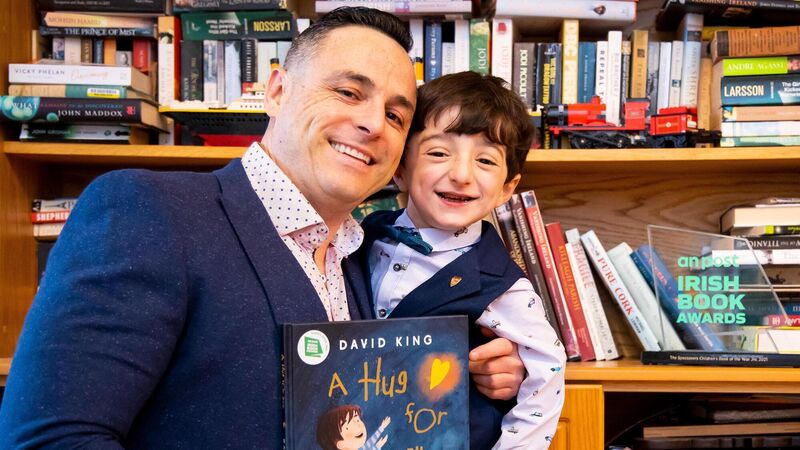One of the first gifts GP Christina McDonnell received for her newborn daughter three years ago was a hardback book called That’s Not My Teddy.
“I thought we’d have to wait a bit to use it until she was older,” says Ennis-based Christina, who recalls wondering about the suitability of such a gift for a tiny baby.
“It was a sensory book, fluffy, crinkly. From the time she could hold anything, she was holding it. She loved me reading it to her, over and over, for months. One year on, she could ‘read’ it because she could recall what was on each page.”
Christina, who founded online children’s bookshop Genius Juniors 20 months ago, now knows her little girl couldn’t have got a better first present.
Children’s book author and mum to 12-year-old twins Bobby and Faye, Eve McDonnell started reading to her children from day one.
“Well, once the chaos settled! As well as reading for the wonderful bonding, the rhythm, the recognising of my voice, the forming of sounds, reading became about shapes, colours, letters, numbers. Best of all, it was about the story.”
Every new parent knows the importance of routine, but Eve points out that once you’ve settled into a routine, it’s almost time to change it. “It was a moving target. They changed out of nappies, stopped having naps. But books remained in our routine and story-time brought great comfort to us all.”
There were certain daily flashpoints when story-time happened. “Bedtime was a given, often straight after bath-time, snuggled up on the couch and sometimes as an alternative to play.”

Multiple benefits of reading
Dr Malie Coyne, clinical psychologist and author of Love In, Love Out, says reading to children from when they’re babies is deeply nurturing. “Children have a language of metaphor and images and imagination. Reading them stories they wouldn’t otherwise hear really plays to their natural language.”
For this reason, stories can have great therapeutic value for children, says Dr Coyne. “Stories can speak to them on a deeper level, a far more immediate level than literal everyday language.”
Award-winning children’s writer David King – dad of Adam, who captured the hearts of Late Late Toy Show audiences in 2020 – recalls a moment when a book had exactly this therapeutic effect on his son who has a brittle bone condition.
“Adam had a fall at home one day. He didn’t break a bone but he was very down on himself, worried he’d have to go to hospital and get surgery. He was genuinely upset.
“I sat with him and I read Dr Seuss’s book, I Wish That I Had Duck Feet, where [the character] wishes he had all these things, like a long tail, a whale spout. It’s very playful and you dance through these rhymes and the big message is: he doesn’t have these things and he’s happy to be himself.
“And after we read it, Adam said: ‘I’m happy to be me too’. So it was a life lesson coming through a story – rather than me just telling him.”
Dr Coyne sees multiple benefits to reading to and with children. “Young children’s concentration wouldn’t be the best. But if from a young age, you’re sitting or lying beside them and they’re listening to a story from start to finish, that develops concentration skills.
“There are so many benefits for cognition – building up brain connections, increasing vocabulary and language.”
And while you’re reading them stories, with elements they won’t understand, you’ll be expanding their language and comprehension – as you add a special voice, repeat stories, chat about them – says Dr Coyne.
“Stories help with problem-solving. They present new creative solutions for seemingly insurmountable problems, but the child realises there are lots of possibilities – and some aren’t the right way to go. Through story, the child almost gets to rehearse these possibilities.”
There’s a book for every reader
Eve McDonnell’s children have always seen their mum read for pleasure.
“The most important thing is them witnessing you read. Children are always happy when Mum and Dad aren’t rushing about. Even today, if I open a book and sit in my chair, I’ll see one or other of them snuggle up next to me with their book.”

Describing the twins’ reading tastes as “like chalk and cheese”, she says Faye used to be hooked on Dora the Explorer but has now moved to contemporary stories. Bobby loves non-fiction books. “For a long time, I labelled him a reluctant reader – until I realised we were going the wrong way. Through the Barrington Stoke books, which use less cramped text and shorter sentences, we discovered Bobby’s buzz was for non-fiction.
“Now I believe there’s a book, or type of book, for every child. It can take a while to find the right one but when you do, it just happens.”
Christina McDonnell says we need to respond immediately if a child asks for a book to be read to them. “Stop what you’re doing – mostly you can, drop to their level and read to them. You’re telling your child ‘you’re worthy of my time’. Get comfortable, snuggle up, spend time together. Maybe you start a sentence, your child finishes it. You laugh at a funny part. There’s this active togetherness.”
By extending her daughter’s comprehension – and expressive skills – through stories, Christina believes the little girl is happier in her life. “She can express her needs and we can meet them. Children can get frustrated if they’ve an unmet need but can’t express it.”
Fit for a King
In the King household, Adam’s mum, Fiona, is passionate about reading stories to children right from the beginning. A former primary schoolteacher, she trained as a reading recovery teacher, working with children who, in the first 18 months of school, experienced literacy difficulties. “I’d do an intensive 10-12 week course with them and see them take off.”
Their five children, ranging in age from 13 to three, don’t go anywhere without a book and the local library is “the most visited place we go”. Fiona recalls how, during the first lockdown, all seven of them would gather around the kitchen table and listen to audio readings of David Walliams’ and Harry Potter books.
“The kids never knew what book or chapter would be read on a particular day so every day they looked forward to something new. Sarah was a three-month-old at the time and I’d be feeding her at the table. David would be on his coffee break. It was a lovely family experience.”
Reading stories to children can happen at any point of the Kings’ day. “Often at breakfast when they’re getting distracted from eating, I read to keep them on task. Always, when the smaller ones came home first from school, I’d read a story to them. It was a personal connection time.
“Nothing can replace reading in your own voice, with your inflection, at your pace. It can’t be recreated on a tablet,” says Fiona.
Reading stories to children is healing, soothing, comforting, says Dr Coyne. “If it’s the last thing you do before bed – and many children find it hard to settle at night – you’re calm together. You’re devoting time to reading, lying or sitting close together. Children love predictable routine – anything shared in a calm space with a child is all they want.”
Currently reading a lot of Roald Dahl with her 11-year-old and almost nine-year-old, she says: “He’s quite rude in ways. But reading normalises stuff they’re afraid of. It takes the sting out of the scares.”
In all kinds of ways, stories for children are a window to another world and they need stories to understand the world. By the time Christina’s daughter had her first visit to the dentist, she knew what to expect – because she’d read a story about it. “She knew what the dentist’s chair was, what the instruments looked like, so she popped up on the chair and opened her mouth.”
Eve’s children had both read The Boy at the Back of the Class, while Bobby had also read graphic novel Illegal – each book explores a refugee theme – ahead of a Ukrainian girl recently joining their class. “It gave them an understanding of her situation,” says Eve.
“But tricky discussions can happen around stories. And when it comes to asking questions about life, books provide a really safe place for them to learn about life.”
- David King’s new book, Sir Adam the Brave and the Moody Monsters, is out next month.
- Visit childrensbooksireland.ie
CONNECT WITH US TODAY
Be the first to know the latest news and updates








